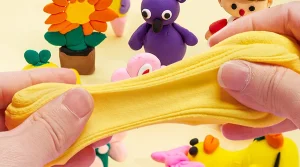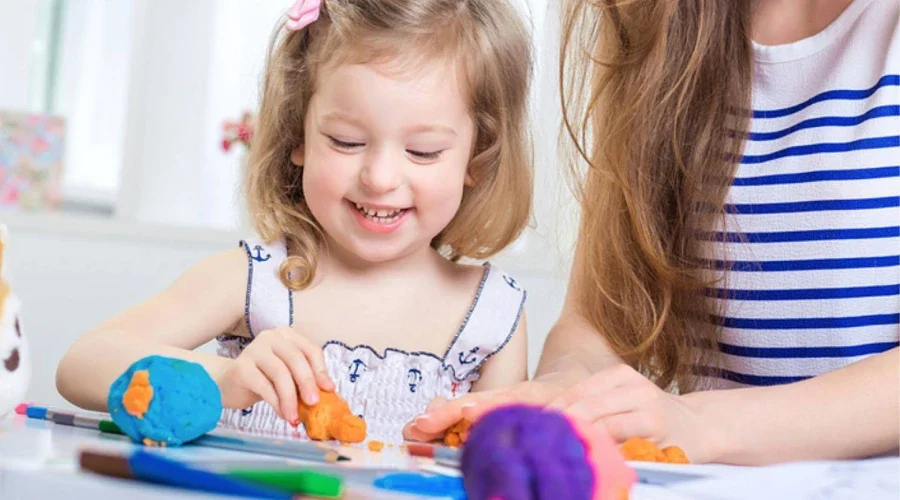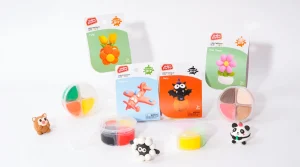
How to Use Lightweight Air Dry Clay?
Find out how to use lightweight air dry clay safely and creatively, from simple shapes to detailed crafts for children and beginners.
#1 Toys Manufacturer in China. WhatsApp: +86 180-0088-4063. Email: [email protected]
#1 Toys Manufacturer in China. WhatsApp: +86 180-0088-4063. Email: [email protected]

Clay modelling has long been a favorite activity for children. From simple animals to tiny houses, shaping clay gives kids a chance to turn soft material into something of their own. It feels playful, yet it also ties to how they learn about touch, form, and patience.
There are many types of clay available today—playdough, polymer clay, and air dry clay are just a few. Each one behaves differently, and some are more suitable for kids than others. Choosing the right clay matters because it shapes not only what they create but also how safe and enjoyable the experience will be.
Clay modelling is more than a pastime. For children, it mixes fun with small lessons about the world. Rolling, pinching, and shaping clay can be simple acts, but they connect strongly to how kids grow, think, and play.
When adults guide children in clay activities, the focus often shifts to both creativity and safety. The kind of clay offered makes a big difference. Soft, safe, and easy-to-use materials can turn play into a comfortable and positive experience.
Clay is a sensory tool. Its texture and resistance let children practice fine motor skills without even noticing. For example, squeezing a lump of air dry clay helps strengthen hand muscles used for writing. Simple play becomes practice for real-life skills.
It also sparks imagination. A child might start by forming a ball, then decide it looks like a planet or an apple. Clay gives room for stories to unfold, and this type of open-ended play is linked with early problem-solving and flexible thinking.
Young children often explore with their hands—and sometimes their mouths. That’s why clay must be non-toxic and free of strong odors or harsh chemicals. Safe labels reassure parents that the material will not harm sensitive skin or health.
Ease of use also matters. Kids are more likely to enjoy clay that is soft and ready to shape. If the material is too tough or sticky, frustration builds quickly. Choosing child-friendly clay keeps the focus on play rather than on struggle.
Not all clay is the same. Some are made for quick play, while others are built for lasting projects. Knowing the differences helps parents and teachers decide what works best for children’s age, safety, and play goals.
Playdough is soft, colorful, and easy to reshape. It works well for short play sessions because it stays pliable and doesn’t need drying or baking. Kids can roll it, cut it, and mix colors freely.
But playdough dries out quickly if left in open air. Its salty base also makes it less suitable for detailed or long-term models. For pure fun, it shines, but it may not be the best choice for projects that children want to keep.
Polymer clay is often used by hobbyists or artists. It comes in many colors and holds fine details well. After shaping, it must be baked at high heat to harden, which creates strong and lasting figures.
For children, though, polymer clay brings challenges. The need for baking makes it less safe and practical at home or in classrooms. Its firmer texture also means younger kids may struggle to mold it. In most cases, it is better for older users.
Air dry clay, often made with a PVA base, is lightweight and smooth. Children can shape it easily with their hands or simple tools. Once finished, it hardens naturally at room temperature without ovens or kilns.
This clay is also designed with safety in mind. Many PVA-based clays are non-toxic and easy to clean. They strike a balance between being fun for play and reliable for small crafts kids want to keep. That makes it a strong choice for child-friendly modelling.
Air dry clay is often considered a favorite when it comes to clay modelling for children. Its design allows kids to enjoy shaping, sculpting, and drying without extra tools. Two main features make it stand out: its lightweight feel and its ability to dry on its own.
Air dry clay has a soft, fluffy texture that feels light in the hands. Kids can pinch, roll, and flatten it without needing much strength. Even small hands can create shapes quickly, which makes it ideal for early learners.
Because of this easy texture, children can try out different ideas without frustration. Mistakes are not a big deal—they can just squish the clay back together and start again. That keeps the activity fun and stress-free.
Unlike polymer clay, air dry clay doesn’t need an oven. It hardens naturally when left out in the open air. This makes it safer for children, since there is no need to handle heat or special equipment.
Once dry, the creations can last for a long time if handled gently. Kids often like to paint or decorate the finished pieces, turning simple play into a small craft project they can keep as a memory.
Safety is always at the top of the list when selecting any toy or material for children. Clay modelling is no exception. Parents and educators should pay attention to the type of clay, the listed ingredients, and the instructions for use.
Non-toxic labels are important because kids often touch their faces or mouths during play. Safe clays avoid harmful chemicals and use ingredients that are gentle on the skin. Eco-friendly options also reduce environmental impact after disposal.
When possible, checking for certifications such as ASTM or EN71 adds another layer of assurance. These standards are designed to confirm that children’s materials meet strict safety requirements.
Some clays, like polymer or ceramic types, require baking or firing to harden. This can introduce risks such as burns or exposure to fumes. For children, these processes are not practical or safe.
Choosing clays that air dry or remain soft avoids these risks. That’s why playdough and PVA-based clays are often considered better suited for safe and simple use at home or in classrooms.
>> Is Modeling Clay Safe for Kids?
Clay modelling is more than just playtime. It gives children the chance to use their hands and minds together. This mix of fun and learning has been well studied in child development research and is often used in both homes and schools.
Working with clay requires small, repeated movements like pinching, rolling, and pressing. These actions strengthen the muscles in the fingers and improve hand-eye coordination. Over time, these skills support tasks like writing or buttoning clothes.
The gradual shaping of clay also helps children practice patience. They learn that careful effort produces better results, which adds a layer of discipline to play.
Clay is open-ended. A ball can become an animal, a cup, or something abstract. This kind of freedom fuels imagination. Kids often surprise adults with the shapes they invent.
Problem-solving also comes into play. For example, if a tower falls over, a child may try a wider base or a different stacking method. This simple trial-and-error approach builds early problem-solving habits.
Not all clays are the same, and each comes with its own strengths and limits. When choosing the best option for kids, it’s helpful to see how air dry clay compares with two of the most common alternatives: playdough and polymer clay.
Playdough is very soft and easy to reshape. It’s perfect for younger children who enjoy quick play and don’t need permanent creations. However, playdough dries out fast if not stored properly and doesn’t hold detail once it hardens.
Air dry clay, by contrast, keeps its shape after drying and can be painted or decorated. This makes it more suitable for older children who want to keep their models as finished pieces.
Polymer clay is dense and requires baking in an oven. While it produces durable results, it’s not ideal for kids due to heat requirements and possible fumes. Handling polymer clay also takes more strength, which can be tiring for small hands.
Air dry clay avoids these issues. It is softer, doesn’t need heat, and is safer for classrooms or home play. While it may not be as durable as polymer clay, it offers a good balance between ease of use and lasting results.
Clay modelling works best when the setting is prepared. A safe and organized space helps kids explore freely without extra stress for adults. Simple steps can turn play into a smooth and positive experience.
Covering tables with cloth or paper makes cleanup faster. Keep bowls of water and towels nearby, but remind children not to soak the clay. Non-stick mats or trays can help prevent pieces from sticking to furniture.
Also, store clay in sealed containers after play. This prevents drying and avoids cross-contamination if multiple children are using the same supply.
Children enjoy freedom with clay, but a balance between open play and small tasks can be helpful. For example, an adult might guide a group to make simple shapes like cubes or spheres, then let the kids create on their own.
This approach keeps structure without limiting creativity. It also allows educators to tie clay play into lessons about math, science, or storytelling.
While clay play seems simple, a few common mistakes can cause problems. Avoiding these pitfalls ensures that children enjoy safe and effective modelling sessions.
Some kids add too much water, turning clay into mud. Over-wet clay is harder to shape and may break apart after drying. Teaching moderation is key.
Mixing different types of clay, such as playdough with air dry clay, often leads to frustration. Each has different drying properties, and combining them usually ruins both.
Younger children should not use small clay pieces unsupervised, as they may put them in their mouths. Even safe clays need watching.
Older kids may not need close supervision, but they still benefit from guidance. Adults can help prevent habits like pressing clay into hair, fabric, or classroom carpets.
Clay has been part of human play and learning for centuries. Across cultures, it has shaped traditions, rituals, and education. Looking at history shows how universal clay’s role has been in child development.
In many ancient communities, children shaped clay into small figures or tools as practice for adult skills. For example, clay tablets in Mesopotamia introduced kids to writing long before paper was common.
In rural societies, clay toys such as whistles, dolls, and animal figures were common, teaching both creativity and cultural values.
Today, clay continues to appear in classrooms from preschool to primary school. Teachers use air dry clay in art and science projects, while Montessori and Reggio Emilia programs emphasize clay as a sensory and expressive tool.
This global practice highlights clay’s flexibility—it adapts to both cultural traditions and modern teaching needs.
Clay modelling blends fun with learning, but choosing the right clay matters. Air dry clay stands out for kids—safe, easy to shape, and lasting—making it a trusted choice for creative play worldwide.
>> What Is the Best Air Dry Clay for Beginners? A Friendly Guide
Yes. Most PVA-based air dry clays are made with non-toxic ingredients and meet child safety standards. Parents should still supervise young kids to ensure safe handling and avoid accidental ingestion.
No. Once air dry clay begins to harden, it cannot return to its soft state. To prevent waste, keep unused clay sealed in an airtight container or wrap it tightly to retain moisture.
Playdough stays soft and is meant for repeated play, while air dry clay hardens over time, allowing children to create lasting models. Each supports creativity in unique ways.
Air dry clay is suitable for children around 4 years and older. Younger kids may find it difficult to handle, so supervision is key to ensure both safety and a positive experience.
Yes. Once fully dry, air dry clay models can be decorated with paints, markers, or other child-safe art supplies. This extends the activity and adds a fun creative layer for kids.
More Related...

Find out how to use lightweight air dry clay safely and creatively, from simple shapes to detailed crafts for children and beginners.

Montessori vs. normal toys: explore how design, purpose, and learning goals shape children’s play and development in meaningful ways.

Explore the truth about air dry clay and water—why it softens, what to avoid, and how to care for your crafts.

Learn the science behind modelling clay: its ingredients, types, safety, and how it compares with playdough and air dry clay.

Our team will answer your inquiries within 48 hours.
Copyright © 2025 GuangDong AKIA Technology Co,. Ltd. All Rights Reserved